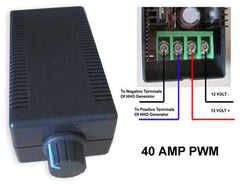The PWM is used to dial in a more precise amperage of an HHO kit. It allows more experimenting for th e best results of each vehicle. For instance: we have had some cars get just as good mileage increase at 18 amps, as they do at 30 amps. So by settling at around 18 amps, the mileage increase was there, Plus, the kit used half of the water as normal, from the reservoir, extending times between refills. This doesn’t always happen...sometimes a car responds better at 25 or 28 amps. The only way to really dial it in, is to test around a little. The PWM allows this tuning capability.
e best results of each vehicle. For instance: we have had some cars get just as good mileage increase at 18 amps, as they do at 30 amps. So by settling at around 18 amps, the mileage increase was there, Plus, the kit used half of the water as normal, from the reservoir, extending times between refills. This doesn’t always happen...sometimes a car responds better at 25 or 28 amps. The only way to really dial it in, is to test around a little. The PWM allows this tuning capability.
When you initially set up an HHO kit, you dial in the approximate amperage draw of the kit, simply by varying the amount of electrolyte you put into the reservoir. Smaller generators actually need More electrolyte than the larger ones (our 881 hho kits use Twice the Electrolyte as our 884 hho kits!). Our manual shows approximate quantities for set up. If you put too little, or too much electrolyte, the amperage level is set, and you can only vary it by either diluting with more water (lowering amperage), or adding more electrolyte (increasing the amperage)). By using a PWM, on the other hand, you can add more than normal electrolyte at setup, and use the PWM to control whether you want zero amps (off), up to 35-38 amps (max recommended with our PWM's).
PWM's work by simply pulsing/modulating the battery current. They control the current by quick pulses (frequency) and adjusting how long those pulses stay on (duty cycle). Some argue that a PWM can create a better form of HHO gas, but I have not seen any proof that way. We have had many customers over the years, get great results with, and without a PWM. We prefer them on any commercial vehicle or cars that drive a lot in hot weather, as you can manually turn them down in the afternoon, if they are running a bit hot. They are also mandatory if you live in freezing weather climates, since you can add much stronger solutions of electrolyte to keep the water from freezing.
While adding or reducing the amount of HHO gas going into an engine may seem counter-intuitive, with this new technology, it is not. There are no precise formulas telling you exactly how much gas is better for any particular vehicle - only approximate rules, and opinions. That’s why a PWM is nice to dial it in to what is right for your vehicle. There are also more expensive PWM's with constant current control, and ability to add water level sensors/as well as connection options to the throttle body of your vehicle, that could control your hho kit precisely with the accelerator, and we will be introducing one soon; but they are not cheap, not really for a backyard experimenter or someone on a tight budget.
While a PWM is not necessary for an hho kit to operate and get results, we have grown to like them more and more as we dial in and play with the generators to get optimum results.